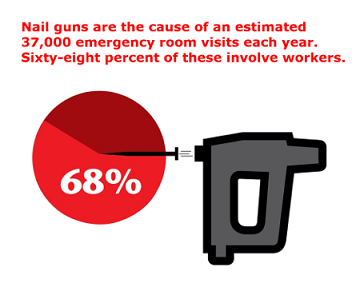- Home
- Loss Control
- Loss Control Insights
- Six Steps to Nail Gun Safety
Nail guns can increase productivity in the workplace, but they also cause an estimated 37,000 emergency room visits each year, according to the Centers for Disease Control and Prevention. And 68% of these visits involve workers.
Common (and Unexpected) Nail Gun Injuries
Unsurprisingly, more than half of reported injuries are to workers’ hands and fingers. But just about any other body part, such as legs, knees, feet and toes, can also attract a stray nail. While many injuries are simply painful, more serious injuries can cause blindness, paralysis, brain injury and even death.What Causes Nail Gun Injuries?
You might wonder how it’s possible to suffer severe injuries from such a common tool. Reported injuries frequently occur from a double fire, with the second nail going “rogue” during recoil. Other common causes include:- Knocking the safety contact when the trigger is squeezed
- A nail penetrating through a lumber work piece
- A ricochet
- Awkward positioning that causes the nail gun to not make full contact with the work piece, allowing the nail to go airborne
- Purposefully bypassing or disabling safety mechanisms
Nail Gun Safety Guidelines
A National Institute for Occupational and Health (NIOSH) report, “Nail Gun Safety: A Guide for Construction Contractors,” outlines six nail gun safety tips.Use the Full Sequential Trigger
This trigger mechanism reduces the risk of unintentional nail discharge and double fires. Studies of residential carpenters found that the overall risk of nail gun injury is twice as high when using contact trigger nail guns compared to using sequential trigger guns.
Provide Training
Both new and experienced workers can benefit from safety training on the causes of nail gun injuries and how to prevent them. It’s recommended that you incorporate hands-on training with the actual nail guns used on the job and include the following training topics:
- Primary causes of injuries
- How triggers differ and how to understand manufacturers’ tool manuals
- Proper use of personal protective equipment (PPE)
- Injury reporting
- First aid and medical treatment
Establish Nail Gun Work Procedures
You need established procedures to help keep employees safe while also holding them accountable. Your safety procedures should include the following rules:
- Check tools and power sources before operating a nail gun
- Keep hands at least 12 inches away from the nailing point at all times
- Always disconnect the compressed air when leaving a nail gun unattended, climbing a ladder or stairs, or passing the nail gun to a coworker
- Never bypass or disable safety features
- Never use a nail gun with your nondominant hand
Provide PPE
Safety shoes, which help protect workers’ toes from nail gun injuries, are typically required by OSHA on residential construction sites. Other protective equipment includes hard hats, high-impact eye protection and hearing protection.
Encourage Reporting and Discussion of Injuries and Close Calls
Reporting an incident helps ensure that employees receive medical attention. It also helps identify unrecognized hazards that could lead to additional injuries if not addressed.
Provide First Aid and Medical Treatment
Employers and workers should seek medical attention after nail gun injuries, even for those that appear to be minor. Studies suggest that one out of four nail gun hand injuries involve some type of structural damage to the body, such as a bone fracture.
5 Bonus Nail Gun Safety Tips From EMC
EMC Loss Control experts recommend several additional safety steps for those using nail guns:- Follow the manufacturer’s instructions for maintaining tools, including details on wiping components, cleaning the air filter and feed system, lubricating, checking seals and hosing, and using the correct type of air compressor for your models.
- Always put all tools and attachments (hoses, nails, etc.) away in the designated storage area after use.
- Review OSHA standards on a regular basis to be sure all power tools are used according to the rules.
- Maintain proper housekeeping in areas where nail guns are used. For example, hoses in walkways or underfoot are a trip hazard and loose nails could penetrate a boot if stepped on.
Periodically review ergonomics best practices to ensure workers are staying safe. Vibrations, awkward postures and repeated exertion can take a toll on workers’ bodies. Solutions include vibration gloves, ergonomic floor mats and frequent rest breaks.
Find more safety information on pneumatic tools like nail guns in this EMC Pneumatic Tool Safety Tech Sheet.
Get in touch
Need help? We’re here for you! Whether you have questions or need personalized assistance, your local office is ready to support you.
Loss Control Insights
Stay informed with the latest news and receive actionable safety tips, all carefully curated by our team of experts.
